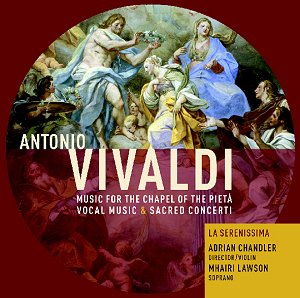The mastermind behind
this terrific CD, Adrian Chandler, is
not only Director of La Serenissima
and a violinist of flair and distinction;
he is also a meticulous scholar, as
his excellent booklet notes reveal.
He has clearly engaged in much fruitful
research in preparing for this recording,
even carrying out imaginative reconstruction
where necessary.
The result is a rich
musical treat. All of this music was
written by the ‘Red Priest’ for use
in the Chapel of the Pietá, the
Convent School for orphans (or ‘foundlings’)
in Venice. The music on the generously
filled disc consists of three instrumental
concerti and two solo vocal cantatas,
Laudate Pueri and Salve Regina.
These are sung by the Scottish soprano
Mhairi Lawson, who turns in thoroughly
delightful performances. She gives the
more lyrical movements, such as the
very beautiful Et Jesum Benedictum
that concludes Salve Regina,
an easy and natural expressiveness,
while she is more than equal to the
bravura of the quicker movements. Laudate
pueri contains much that represents
Vivaldi at his very best, for example
Quis sicut Dominus with its tip-toeing
staccato in the strings.
This, and all the other
instrumental music, is realised superbly
by the players of La Serenissima, the
enlarged chamber ensemble named after
the city of its inspiration; the name
being, of course, a poetic soubriquet
for Venice itself. The string sound
is pure and bold, yet capable of great
subtlety when required. They are underpinned
by a continuo section of great richness:
the harpsichord of Joseph McHardy, the
theorbo (bass lute) of Richard Sweeney,
and the organ playing of Robert Howarth.
Despite the scholarship,
there is nothing ‘academic’ about the
performance of this music. Indeed, it
is exuberant and often full of élan
and humour. The final movement of RV554a
is a sprightly Allegro which
inspires McHardy to an outrageous three
octave glissando, more normally associated
with jazz pianists – fun!
Elsewhere, fine contributions
come from cellist Sarah McMahon and
organist Robert Howarth, the latter
in the two concerti with organ solo
parts. It’s not clear whether Howarth
is playing the organ of the lovely old
church in East Sussex where this is
recorded; I doubt it, as, as far as
I can gather, that instrument dates
only from the late 19th century.
Thus I think it is an imported chamber
instrument that is used. Very fine it
sounds, too.
The balance at all
times is exemplary – everything can
be heard with clarity and great beauty.
Vivaldi is a funny old composer; sequences
of mind-numbing repetitiveness are so
often succeeded by sudden twists of
utter harmonic or textural magic. Infuriating,
but, in performances as wonderful as
these, you can’t help loving it!
Gwyn Parry-Jones

![]() Mhairi Lawson (soprano), Sarah McMahon (cello
solo), Robert Howarth (organ)
Mhairi Lawson (soprano), Sarah McMahon (cello
solo), Robert Howarth (organ) ![]() AVIE AV2063 [79:58]
AVIE AV2063 [79:58]






